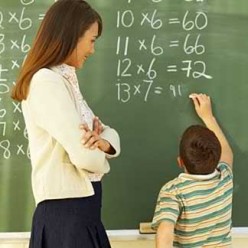 “To be a teacher in the right sense is to be a learner. Instruction begins when you, the teacher, learn from the learner, put yourself in his place so that you may understand what he understands and in the way he understands it.” –Soren, Kierkegaard (1848), “The Point of View for My Work as an Author”
“To be a teacher in the right sense is to be a learner. Instruction begins when you, the teacher, learn from the learner, put yourself in his place so that you may understand what he understands and in the way he understands it.” –Soren, Kierkegaard (1848), “The Point of View for My Work as an Author”
The first week in the classroom is difficult for many teachers who struggle to find that balance between establishing structure and control while also cultivating relationships and community with students. It can be exhausting when some students are not as responsive as others to instructions.
Learning itself is a particular neurobiological process, distinct from other aspects of personality. Yet, laying an effective foundation within a classroom community that optimizes learning is a psychological enterprise. Many teachers intuitively understand this but are not confident in managing behavior.
Let’s consider some of the dominant factors that may influence the personality and behavior of students.
Character
Each child’s early identity has been in the process of being forged socially—in a particular family, social, and subcultural context—which influences their internalized values and manners.
Expressions of character outside of what is acceptable in schools may occasionally be cultural. There are times when teachers need to proceed with sensitivity and curiosity to better understand tendencies of children in their cultural or subcultural context, while remaining aware of their own biases.
Character development is influenced by everything from religion, to morality and ethics, to ethnicity, to socioeconomic class. Character development is also influenced by attachment relationships.
Attachment
The degree of closeness or distance, volatility or peace, abuse or neglect within particular families is a crucial developmental crucible in which children are fired and molded. Depending on children’s relationships with caregivers, they may be more relatable, withdrawn, or disruptive with teachers.
But children who have had adverse or negligent relationships with parents or other caregivers are likely to be self-doubting and behave in either more withdrawn or more disruptive ways. Juliet Hopkins wrote, “In homes where the baby finds no mutuality, where the parent’s face does not reflect the baby’s experience, and where the child’s spontaneous gesture is not recognized or appreciated, neither trust in others nor confidence in the self develop.” Many students may come from such homes.
Teachers should keep in mind, as Mary Boston and Rolene Szur noted, that “It makes a great deal more sense of much of the seemingly unreasonable or outrageous behavior of many…children if one bears in mind that they are often doing to others what they experience as being done to them, both externally and internally.” Though it can be an emotionally exhausting task, empathy and sensitivity to students’ anxieties brought from home can have positive effects on a child’s availability to learning.
Alan Sroufe and Daniel Siegel described data collected by the Minnesota Longitudinal Study of Risk and Adaptation (MLSRA), a research project begun in 1976:
“Teachers, too, with no knowledge of the child’s history, treat children in the different categories of attachment differently. Coders, who were blind to the child’s history, but who watched videotapes of interactions between teachers and each child, rated teachers as treating those with secure histories in a warm, respectful manner. They set age-appropriate standards for their behavior and had high expectations for them (indicated by actions such as moving on to take care of other tasks after asking the child to do something). With those having resistant histories, the teachers were also warm, but highly controlling. They didn’t expect compliance, set low standards, and were unduly nurturing (taking care of things that 5-year-olds should do for themselves). Teachers were controlling and had low expectations with the avoidant group, but displayed little nurturing and got angry at them most frequently. Thus, the reactions of teachers tended to support the attachment assessment of the children that had been made through other observations.”
This research offers a fascinating snapshot of just how powerful children’s attachment relationships from home affect the perceptions that their teachers have of them even without clear knowledge of their home life or family relationship history. Certainly, teachers are not therapists and are not in a position to pry for such information, nor should they.
Nonetheless, teachers should be mindful. They should be mindful not only of the ways they interact and react with their students, but they should also, over the course of time, be mindful of their own character formation, their own attachment history, and their own inborn temperament. These are powerful forces that have the potential to be unwittingly projected onto students by teachers.
Temperament
Children enter the school year as living, breathing, unique human beings with more than 125 distinct chemicals firing off in their brains’ neurochemistry that shape the particular ways they feel, think, and behave. These inborn neural predispositions set the stage for a child’s temperament.
Kathy K. Oliver described the nine characteristics of temperament originally developed by researchers Alexander Thomas and Stella Chess.
- Activity: Is the child always moving and doing something, OR does he or she have a more relaxed style?
- Rhythmicity: Is the child regular in his or her eating and sleeping habits OR somewhat haphazard?
- Approach/Withdrawal: Does he or she “never meet a stranger” OR tend to shy away from new people or things?
- Adaptability: Can the child adjust to changes in routines or plans easily, OR does he or she resist transitions?
- Intensity: Does he or she react strongly to situations, either positive or negative, OR does he or she react calmly and quietly?
- Mood: Does the child often express a negative outlook, OR is he or she generally a positive person? Does his or her mood shift frequently, OR is he or she usually even-tempered?
- Persistence and attention span: Does the child give up as soon as a problem arises with a task, OR does he or she keep trying? Can he or she stick with an activity a long time, OR does his or her mind tend to wander?
- Distractibility: Is the child easily distracted from what he or she is doing, OR can he or she shut out external distractions and stay with the current activity?
- Sensory threshold: Is he or she bothered by external stimuli such as loud noises, bright lights, or food textures, OR does he or she tend to ignore them?
Thomas and Chess (1977) grouped children with varying characteristics of temperament into three major constellations: Easy (flexible), Difficult (active or feisty), and Slow-to-Warm-Up (cautious).
Teachers, of course, tend to value particular qualities of temperament over others in their classrooms. Teachers hope for a class of easy, flexible students. Adaptability, approach, persistence, and positive mood are more highly valued in school settings, according to Barbara K. Keogh.
Keogh examined several studies that have explored correlations between teachers’ expectations for students’ success in their classrooms and children’s behaviors in their classrooms. She concluded, “Children’s behavioral styles that are consistent with teachers’ expectations have a good probability of leading to compatible and positive experiences in the classroom for both students and teachers.
This means that teachers should really wrestle with understanding the nuances of their students’ psychological profile. Issues of character, attachment, and temperament are highly relevant to teachers’ efforts to nurture a working bond with their students and promote achievement.
The Matrix of Personality, Behavior, and Learning
Character development can be affected by attachment in significant ways. So, you can place attachment under the umbrella of character development or socialization. Temperament, on the other hand, is a separate domain of personality, which involves inborn, hardwired traits. David Keirsey described personality as the junction of temperament (nature) and character (nurture).
Whereas understanding students’ personalities is of enormous relevance to classroom management and, ultimately, the learning process, intelligence itself—or the capacity to learn—is basically unrelated to personality. Keogh stated, “The concordance between intelligence and temperament is modest.” In my opinion, stress from home life transported to school in the thoughts and emotions of a child can and will absolutely affect that child’s readiness and capacity to learn.
Implications for the Classroom
The degree to which teachers understand their students’ character, attachment, and temperament profiles can have a significant impact on the formation and effectiveness of their relationships in the classroom.
And, the subsequent manner in which teachers and students relate to one another have important—often underacknowledged—effects on students’ developing confidence and self-identity, as well as their engagement in the learning process and educational achievement.
Because of children’s individual differences, the same classroom environment, the same teacher, and the same classroom management techniques will be experienced differently by different children. Teachers would do well to work through a process of crafting a varied selection of behavior control techniques, according to Mary K. Rothbart and Laura B. Jones (1998). Some may work better with flexible kids; others may fare better with the feisty ones.
Developing and maintaining an awareness of individual differences in students’ personalities helps teachers to anticipate situations in which problems are most likely to occur, such as during transitions. According to Keogh, teachers would do well to customize techniques that work well for their particular students during the stress of these moments.
The work of managing a class of students is already difficult and complicated. Yet, I think teachers who do incorporate an awareness and responsiveness to their particular students’ styles of relating, responding to direction, expressing emotion, and processing information will reap rewards over the long haul.
References:
- Boston, M., Szur, R. (Eds.) (1983). Psychotherapy with severely deprived children. London: Routledge & Kegan Paul
- Bowlby J (1980). Loss: Sadness & Depression. Attachment and Loss (vol. 3); (International psycho-analytical library no.109). London: Hogarth Press.
- Hopkins, J., and Horne, A. (2015). An Independent Mind Collected papers of Juliet Hopkins. Hoboken: Taylor and Francis.
- Keirsey, D. (1998). Please understand me II: Temperament, character, intelligence. Del Mar, CA: Prometheus Nemesis.
- Keogh, B. (1986). Temperament and Schooling: Meaning of “Goodness of Fit”? New Directions for Child and Adolescent Development, 1986(31), 89-108. doi:10.1002/cd.23219863107
- Kierkegaard, S., & Lowrie, W. (1962). The point of view for my work as an author; a report to history, and related writings. New York: Harper.
- Oliver, K. (n.d.). Family Life Month Packet 2002. Retrieved from http://ohioline.osu.edu/flm02/FS05.html
- Rothbart, M., & Jones, L. (1998). Temperament, Self-Regulation and Education. School Psychology Review, 27(4), 479-491.
- Sroufe, A., and Siegel, D. (n.d.). The Verdict Is In: The case for attachment theory. Retrieved from http://www.psychotherapynetworker.org/magazine/recentissues/1271-the-verdict-is-in?start=3
© Copyright 2011 by Blake Edwards. All Rights Reserved. Permission to publish granted to GoodTherapy.org.
The preceding article was solely written by the author named above. Any views and opinions expressed are not necessarily shared by GoodTherapy.org. Questions or concerns about the preceding article can be directed to the author or posted as a comment below.

 Back-to-School Tips for Children and Teens with ADHD
Back-to-School Tips for Children and Teens with ADHD Are Your Child’s Emotions Dictating Your Parenting?
Are Your Child’s Emotions Dictating Your Parenting? 6 Strategies to Use at Your Next Parent-Teacher Conference
6 Strategies to Use at Your Next Parent-Teacher Conference